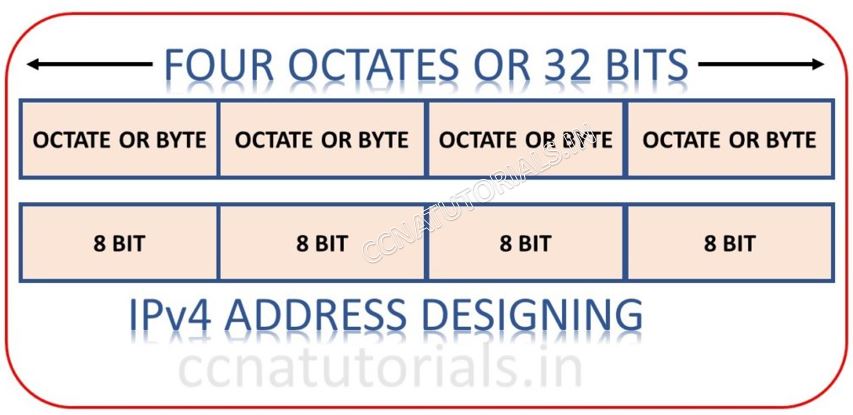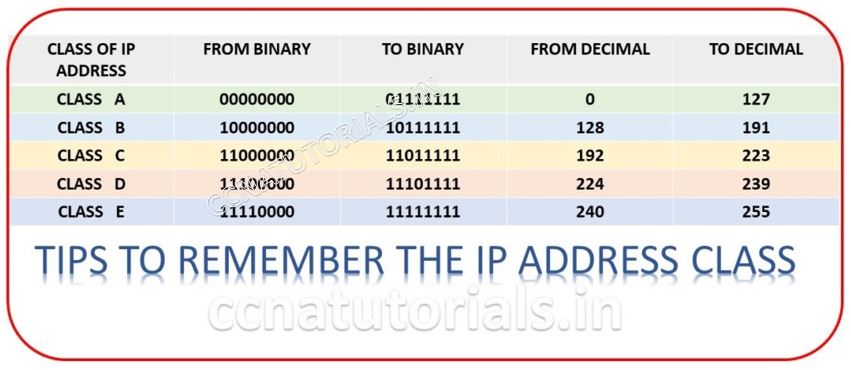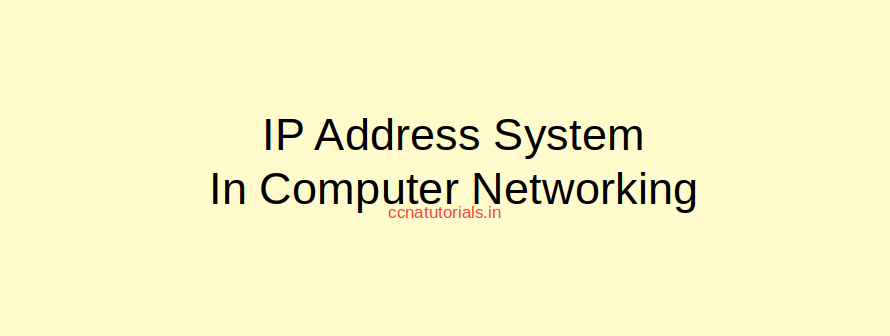In this article I describe the IP address system in computer networking for CCNA Exam . IP address is the identity of any device in a network. Without IP address any device can not communicate with the network or other devices. IP is acronym of Internet Protocol. In any network the devices are identify by its unique IP address.
IP protocol works on internet layer in TCP/IP model. IP address system created by fix length binary numbers. The IP address system in computer networking is a logical numeric address alloted to devices in the network. MAC address is the hardware address and never change in any network.
The IP address can be changes for each device in a network. IP system was designed to allow hosts to communication with each other. IP system is the identity of any hardware device for communication. The IP system is of two types IPV4 and IPV6. Here in this article we discuss about IPV4 only. There is a separate article for IPV6 on this website.
Terminology of IP address system in computer networking
Before going to explain IP address system in computer networking. Some terms are necessary to know which are used in IP address system in computer networking. A Bit may be either 0 or 1. One Byte is equal to 8 bits. One Octat is equal to 8 bits and. Network Address is the designation used in routing protocols for sending the data. It is basically the first address of any subnet.
Network address never used by any device. Network address is the identity of any network. Broadcast Address is used to send data to all nodes in a network. Broadcast address is the last IP of any subnet. In any network Network address and Broadcast address never assigned to any device. For example 192.168.1.3/24 IP belongs to Network ID 192.168.1.0/24 and Broadcast ID is 192.168.1.255/24.
Network Id is the IP address which use to identify the network. The first IP address of a block of IP address is known as network Id. The last IP address of the IP block is known as broadcast ID. For example 192.168.1.3/24 IP belongs to Network ID 192.168.1.0/24 and Broadcast ID is 192.168.1.255/24.
Designing of IP address system in computer networking
An IPv4 is a combination of 32 bits binary digits. Each bit either 0 or 1 but not blank. 32 bits further divided into four Octate. IP can be written in two formats Binary or Decimal. Computer change the decimal into binary during communication. Example of IP in decimal is 10.0.0.0 same in binary 00001010.00000000.00000000.00000000 .

Users does not used the IP in binary system. It is not easy to remember a 32 bit long binary number. During configuration in devices or routing we use the decimal format of IP . Some times IP is also written in Hexadecimal known as IPv6. We discuss decimal and binary format in this article.
Structure of IP address system in computer networking
By using 32 bit binary IP we have approx 232 IP which is equal to 4.29 billion approx. These are sufficient to provide connectivity to devices worldwide. We got sufficient IP to use but the problem is that how a Router can store 4.29 billion address in its routing table.
If each router in world keep these all address in it then the data flow speed become very slow. To overcome this problem IP is further divided into network and host part. Subnetting is come to picture to avoid this problem. Class or IP defines by dividing the IP into network and host segments.
Network Addressing for IP address system in computer networking
In any IP some bits keep fix to define network address. Remain bits are changeable and used for Host. For example in IP 192.168.1.0/24 first three byte remain same for each device in this network. 192.168.1 remains unchanged 192.168.1.0 is the Network Id and 192.168.1.255 is broadcast address. There can be 252 devices connects in this network. 252 devices can use the IP addresses from 192.168.1.1 to 192.168.1.254.
In four bytes we can fix either first octate for network or first two octate or first three octate. IP class is also defining by the network bits. It is depends on your network how many hosts you want to join in the network. For small number of network and large number of host class A network created. For large number of networks and small numbers of host class C network created.

Class A address in IP system
IP address is a combination of 32 binary bits. In Class A network the very first bit remains unchanged and should be 0. All remains 31 bits can be changed for assigning IP to host. The first octate looks like 0xxxxxxxx where x can be 0 or 1. So the range or Class A in IP system is from 00000000.00000000.00000000.00000001 to 011111111.11111111.11111111.1111110
In decimal it denotes 0.0.0.1 to 127.255.255.254. Remember Network ID and Broadcast address consume two IP addresses that’s why 1.0.0.0 and 127.255.255.255 exempted in Class A in IP system. Because they are reserve addresses as discussed earlier.
Class B address in IP system
IP is a combination of 32 binary bits. In Class B network the first bit remains 1 and second bit remains 0 of first octate. All remains 30 bits can be changed for assigning IP to host. The first octate looks like 10xxxxxxxx where x can be 0 or 1. So the range or Class B in IP system is from 10000000.00000000.00000000.00000001 to 101111111.11111111.11111111.1111110
In decimal it denotes 128.0.0.1 to 191.255.255.254. Remember Network ID and Broadcast address consume two IP addresses thats why 128.0.0.0 and 191.255.255.255 exempted in Class B address in IP system. Because they are reserve IP addresses.
Class C address in IP system
IP is a combination of 32 binary bits. In Class C network the first 2 bits remains 1 and third bit remains 0 of first octate. All remains 29 bits can be changed for assigning IP to host. The first octate looks like 110xxxxxxx where x can be 0 or 1. So the range or Class C address in IP system is from 11000000.00000000.00000000.00000001 to 11011111.11111111.11111111.1111110
In decimal it denotes 192.0.0.1 to 223.255.255.254. Remember Network ID and Broadcast address consume two IP addresses that’s why 192.0.0.0 and 223.255.255.255 exempted in Class B address in IP s system. Because they are reserve IP addresses.
Class D address in IP address system
Class D addresses are reserve for research purpose. In symmerty to above address classes.In Class D network the first 3 bits remains 1 and fourth bit remains 0 of first octate. All remains 28 bits can be changed for assigning IP to host. The first octate looks like 1110xxxx where x can be 0 or 1. So the range or Class D in IP system is from 11100000.00000000.00000000.00000001 to 11101111.11111111.11111111.1111110
In decimal it denotes 224.0.0.1 to 239.255.255.254. Remember Network ID and Broadcast address consume two IP addresses that’s why 224.0.0.0 and 239.255.255.255 exempted in Class D address in IP system. Because they are reserve IP addresses.
Class E address in IP address system
Class E addresses are reserve for research purpose. In symmerty to above address classes. In Class E network the first 4 bits remains 1 of first octate. All remains 28 bits can be changed for assigning IP to host. The first octate looks like 1111xxxx where x can be 0 or 1. So the range or Class E in IP address system is from 11110000.00000000.00000000.00000001 to 11111111.11111111.11111111.1111110
In decimal it denotes 240.0.0.1 to 255.255.255.254. Remember Network ID and Broadcast addresses consume two IP addresses that’s why 240.0.0.0 and 254.255.255.255 exempted in Class D address in IP system. Because they are reserve IP addresses.
Subnet Mask In IP address system
Subnet Mask defines the network and host in a network. The Subnet mask distinguish the network ID and Host ID in a packet. A Subnet mask is logical segment of IP address in a network. Subnet is a 32 bit binary number combination. To make it user friendly and easy to remember the subnet mask allotted in decimal format. Internally the device convert decimal to binary number. 32 bits are combination of 0 and 1.

Subnet make it easy to identify the class of network. Class A, B and C uses default subnet masks “255.0.0.0”, “255.255.0.0” and “255.255.255.0” respectively. The above values are fix for classfull system. When we working in VLSM( Variable Length Subnet mask) and CIDR (Classless Inter Domain Routing) the subnet has not fix value. We can say there is no class in the network.
Structure of subnet mask.
Subnet is a part of IP address scheme for a device in network. It is a logical part of IP address system. Subnet Mask separates the network ID and host ID in the network. In a network the hosts which lies in the same subnet come in particular subnet. Subnetting in a LAN done by defining the subnet in hosts IP address schema. For example all hosts having subnet 255.172.0.0 communicate with each other. Other hosts which do not have subnet 255.172.0.0 can not communicate with them without a router.
Important facts about the subnet mask
Subnet masking breaks the large network into small sub networks. It is helpful to control the network congestion. You can assume the traffic flow in a large network create data loss and other negative factors. These drawbacks overcome by creating subnetting. Subnetting can be done by defining the subnet in hosts.
Without subnet all device monitor the data flow in the network from all devices. Due to this the data traffic become very congested. Data transfer speed also became slow. You can assume the benefits of subnet . When you design a network firstly you keep in mind how many host can be added in the network. Along with numbers of hosts, number of networks also important.
In this article I describe the IP address system in computer networking with subnet mask. I hope you found this article helpful for any networking exam like ccna. For any query or suggestions on this topic you may drop a comment below or contact us. Your suggestions are always welcome by us.







Like!! I blog quite often and I genuinely thank you for your information. The article has truly peaked my interest.